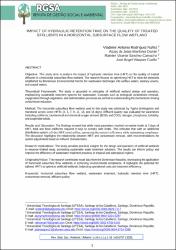Mostrar el registro sencillo del ítem
Impact of hydraulic retention time on the quality of treated effluents in a horizontal subsurface flow wetland
| Licencia | This work is licensed under a Creative Commons Attribution 4.0 International License. | es |
| Autor | Rodríguez Núñez, Vladimir Antonio | |
| Autor | Martínez Durán, Atuey de Jesús | |
| Autor | Sánchez Camacho, Sánchez Camacho | |
| Autor | Vásquez Cuello, José Ángel | |
| Fecha de admisión | 2025-09-04T20:58:14Z | |
| Fecha disponible | 2025-09-04T20:58:14Z | |
| Año | 2025 | |
| Citación | Rodríguez Núñez, V. A., Martínez Durán, A. D. J., Sánchez Camacho, R. V., & Vásquez Cuello, J. Á. (2025). Impact of hydraulic retention time on the quality of treated effluents in a horizontal subsurface flow wetland. Revista de Gestão Social e Ambiental, 19(1), e010757. Recuperado de: | es |
| URI | https://bvearmb.do/handle/123456789/6712 | |
| Sinopsis | Objective: This study aims to analyze the impact of hydraulic retention time (HRT) on the quality of treated effluents in a horizontal subsurface flow wetland. The research focuses on optimizing HRT to meet the standards established by Dominican Environmental Norms for wastewater discharges into surface waters, sanitary sewers, and coastal waters. Theoretical Framework: The study is grounded in principles of artificial wetland design and operation, emphasizing sustainable treatment systems for wastewater. Concepts such as biological contaminant removal, oxygenation through vegetation, and sedimentation processes are central to understanding the mechanisms driving contaminant reduction. Method: The horizontal subsurface flow wetland used in this study was colonized by Typha domingensis and monitored across seven HRTs (3, 5, 7, 9, 11, 13, and 15 days). Effluent quality was evaluated for parameters including coliforms, biochemical and chemical oxygen demand (BOD5 and COD), nitrogen, phosphorus, turbidity, and suspended solids. Results and Discussion: The findings showed that while most parameters reached normative levels at 3 days of HRT, total and fecal coliforms required 9 days to comply with limits. This indicates that with an additional disinfection system, a 3-day HRT could suffice, optimizing the system’s efficiency while maintaining compliance. The discussion highlights the relationship between HRT and contaminant removal, with recommendations for system adjustments based on influent characteristics. Research Implications: The study provides practical insights for the design and operation of artificial wetlands in resource-limited areas, promoting sustainable water treatment solutions. The results can inform policy and improve the efficiency of wastewater treatment practices in tropical and subtropical regions. Originality/Value: This research contributes novel data from the Dominican Republic, showcasing the application of horizontal subsurface flow wetlands in achieving environmental compliance. It highlights the potential for tailored HRTs to optimize artificial wetlands, balancing operational costs and treatment efficiency. | es |
| Idioma | English | es |
| Publicado | Revista de Gestão Social e Ambiental, 19(1), e010757 | es |
| Derechos | Available at: https://rgsa.openaccesspublications.org/ | es |
| URI de derechos | https://creativecommons.org/licenses/by/4.0/ | es |
| Materia | Recursos naturales - República Dominicana | es |
| Materia | Recursos hídricos | es |
| Materia | Contaminación ambiental | es |
| Título | Impact of hydraulic retention time on the quality of treated effluents in a horizontal subsurface flow wetland | es |
| dc.identifier.doi | https://doi.org/10.24857/rgsa.v19n1-031 | |
| Tipo de material | Article | es |
| Tipo de contenido | Scientific research | es |
| Acceso | Open | es |
| Audiencia | Technicians, professionals and scientists | es |
Ficheros en el ítem
Este ítem aparece en la(s) siguiente(s) colección(es)
-
Investigación ambiental [1759]


